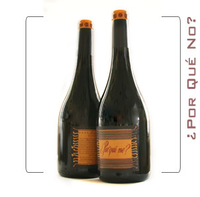Tres Sabores, Napa Valley “¿Por Qué No?” 2010 ($28): I have known Julie Johnson for decades but, as can happen all too easily these days, I had lost touch with her activities, except to know that she had moved from Frog’s Leap Winery, (which she co-founded) to a new venture in Napa Valley called Tres Sabores. Our paths crossed again recently at a conference for women involved in the wine business — logically, because our earliest associations involved Women For Wine Sense, an  organization that Julie co-founded in 1990 with Michaela Rodeno. I was fascinated by the story of her winery and impressed by the wines she makes.
organization that Julie co-founded in 1990 with Michaela Rodeno. I was fascinated by the story of her winery and impressed by the wines she makes.
Tres Sabores, meaning “three flavors,” is a wine ranch in the western hills of the Rutherford district of Napa Valley, situated high on the Rutherford bench area. The ranch organically grows not only grapes — Cabernet Sauvignon, Zinfandel, Petite Sirah, and Petit Verdot — but also olives and pomegranates. The ranch’s animal residents are as cherished as the crops; the winery’s website pays homage to the dogs, cats, sheep, and guinea hens that are integral players in the ecosystem of the farm.
The original concept of Tres Sabores was to produce three Zinfandel wines from the same vineyard, each vinified by a different winemaker (who had the option of blending in Cabernet Sauvignon, Petite Sirah, Cabernet Franc and/or Petit Verdot) so that the three wines would be unique expressions of the same vineyard and dominant grape variety, and differing human elements. After four years, with disparate small lots of wines in the cellar, Julie and her team considered making a blended wine, and decided, “Why not?” That wine became “Por qué no?” vintage 2000. The following year, Julie increased production to make the wine an official part of the portfolio. (In 2005, the winery lost 2000 cases of wine in an infamous, arson-perpetrated warehouse fire that destroyed millions of bottles. That loss led to Tres Sabores’ decision to embrace Sauvignon Blanc — sourced from Farina Vineyard on Sonoma Mountain — which filled the gap when the winery had no red wine to sell, and today remains in the portfolio.)
“¿Por Qué No?” is a blend of the property’s four red grape varieties from estate fruit supplemented with fruit from local growers. In 2010, the blend is officially half Zinfandel with 35 percent Petite Sirah, 14 percent Cabernet Sauvignon and 1 percent Petit Verdot. Winemaking is fairly artisanal, involving hand-picked grapes fermented in open-top, one-ton bins, and basket-pressed into mainly French oak barrels and some American oak.
Blending Cabernet and Zinfandel is certainly unconventional, but in this wine it does work. The wine is a dry, nearly full-bodied red with lots of flavor and an exuberant, inviting personality. The wine’s aromas and flavors are complex, suggesting spicy notes such as black pepper and fruity elements that range from dark plum to black cherry and blackberry, as well as a subtle earthy edge. Behind the sheer likeability of the wine are solid indications of quality: Soft, unobtrusive tannins that let the fruit shine; mid-palate depth and energy; concentration of flavor; and long persistence across the full length of the mouth, ending in a long and flavorful finish.
Julie’s own description likens the wine’s taste to a dance piece. “Zinfandel aromas are the first movement: Bright, zippy, jazzy, forward berry fruit. Cabernet establishes a middle in the wine: rich, languid red velvet. The Petite Sirah comes on more at the end — bolder moves, more earthy — but with a white pepper kick that supplements what the spicy Zin is already doing. The Petit Verdot is more like a cheerleader, in and out of the aromas and flavors — brighter, substantial — but with lots of waving around of color and flavor as well.”
On my table, I would especially enjoy this wine with spicy Mexican or Indian dishes, because its high quotient of flavor and fruitiness can rise to the challenge of the heat. I’d enjoy it also with grilled meats, slow-roasted short ribs, simple roast chicken, or pizza. Although it has the integrity to age, I recommend enjoying it young, now and over the next two years.
90 Points
